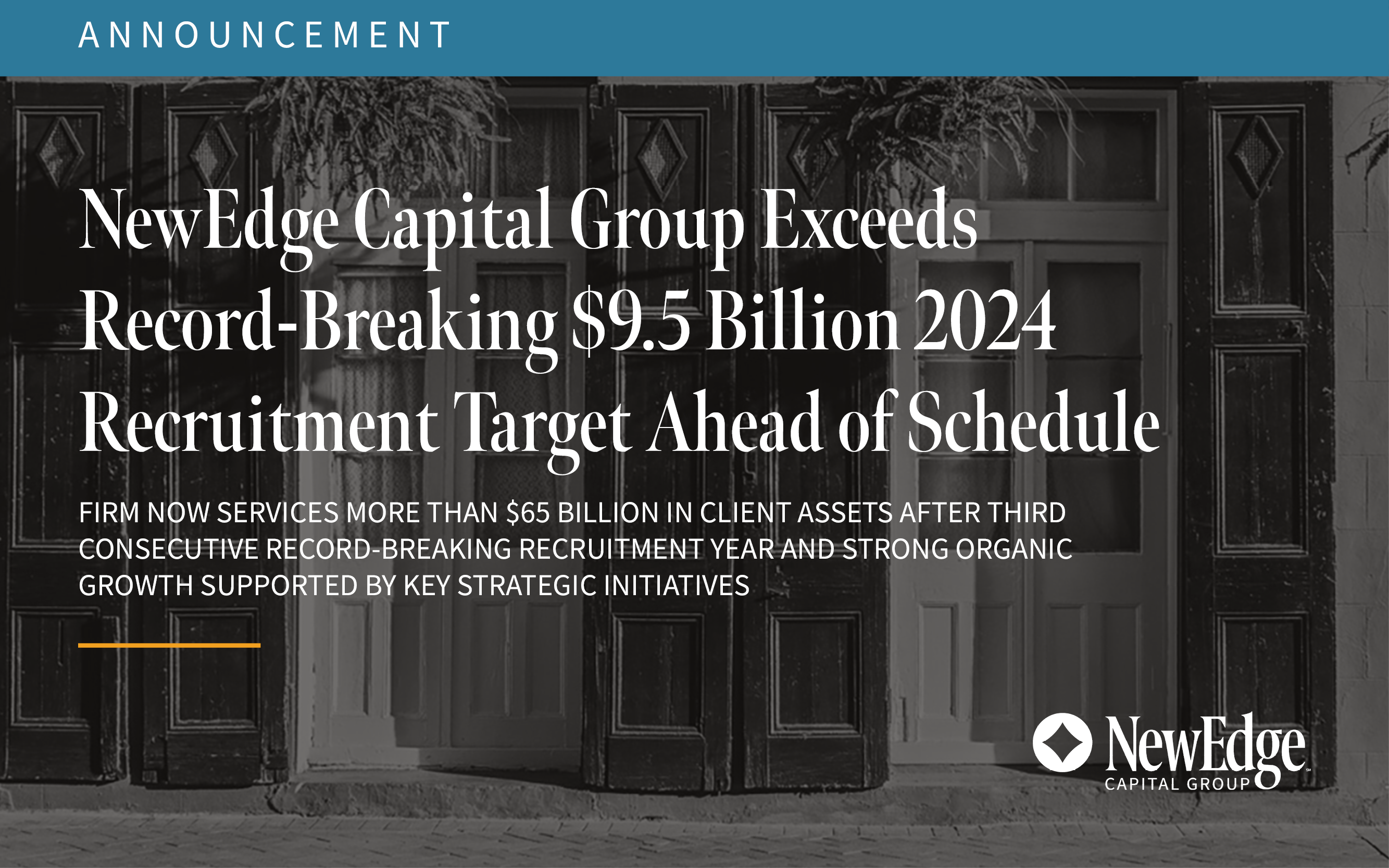The Week at a Glance: May 7 – 14, 2021
Economic data continue to surprise on the upside both in the U.S. and abroad. Financial market reactions have become unpredictable. Interest rates continue to lack “price discovery” information. It’s hard to find any sectors more predictive than others. And while there’s overwhelming evidence of inflation, the debate continues as to whether price increases are transitory or will prove to be persistent.
Key observations:
- Inflation concerns continue to increase, and we believe they were the driving force behind this week’s decrease for most equities’ and—finally—at least initially, the rise in interest rates.
- Interest rates have become a lagging indicator because they now lack “price discovery” information due to an intentional distortion of rates by the world’s major central banks.
- Market sentiment seems to be growing that inflation could become more persistent—and leave the Fed behind the curve.
Earnings season — the final stretch
What did this earnings season show about the predictability of earnings and revenues? A May 7 FactSet report, based on actual results announced by 88% of S&P 500® companies, found that 86% beat EPS estimates and 76% topped revenue expectations. (FactSet, May 7, 2021 report). If these numbers had carried over to the entire S&P companies report, it would have been the most positive EPS surprises since 2008. Clearly, most investors continue to underestimate the magnitude of the ongoing economic rebound. The persistence of inflation is generally underestimated as well.
Many of these stellar earnings reports were met with mostly muted—if not negative—reactions among stock prices. Perhaps it was because the S&P’s forward 12-month P/E ratio was 21.6—well above the five-year average of 17.9 and 10-year average of 16.0. (FactSet, May 7, 2021 report). But there’s another possibility: At these historically high valuations, investors may feel that they simply need more certainty about the trajectory of the economy, inflation, sectors, and individual companies. Happily, the future will become more predictable as economies begin to reopen in earnest.
The markets’ flustering fluctuations
In the meantime, some daily fluctuations in financial markets were simply head-scratching. Technology was the worst-performing sector (down 2.53%) on Monday. This included the “FAAMG” stocks—Facebook, Apple, Amazon, Microsoft and Google (Alphabet)—all of which fell by more than 2%. The most widely accepted explanation was that tech stocks fell victim to inflation concerns. And yet (scratch head, repeat) the 10-year Treasury yield rose by only 2 bps, to 1.60%.
Moreover, Monday’s best performer was utilities (+1.01%), followed by consumer staples. These sectors historically have done very well in stable-to-lower interest rate environments. Yet on Tuesday, high tech (although still lower) was the second-best performing S&P 500 sector, while utilities had fallen to near the back of the pack, at No. 8. Interest rates rose slightly, as they had the previous day.
All of this beggars a question: Do investors in different sectors perceive the current and future environments in meaningfully different ways? Utilities and consumer staples took their cues from a more stable interest rate environment, but other sectors are less sanguine about rates. The short-term outlook for many tech and other big-cap, quality growth stocks has become increasingly fuzzy. How much demand for high-tech products resulted from the pandemic? What will growth look like post-COVID-19? Which sectors will be hit hardest by inflation as input costs rise and margins compress? Which will react most to worker shortages and rising labor costs? Don’t look to the major analysts for definitive answers, at least not yet: In a May 12, 2021 report, Goldman Sachs offered three different scenarios for how European travel prices would affect inflation in the continent. These types of uncertainties will diminish as reopenings become more fully realized.
Calmer seas…in stretches (now not so much)
There have been two stretches of relative predictability since the start of the pandemic last March. The first found interest rates heading lower and FAAMG, “cloud”-related, and “stay-at-home” stocks moving higher. The second trend, starting in early September, saw FAAMG stocks start to decline and interest rates begin to climb. This is when value and cyclical stocks began to outperform.
But things have become much harder to forecast since the end of the first quarter, marked by wildly different forecasts. Interest rates have generally trended lower but have fluctuated within narrow ranges. Inflation expectations now seem to drive many market movements, especially in the more erratic sectors. In general, commodities have continued to rise, further exacerbating inflation concerns.
The irony of these trends is that in times of the greatest uncertainties—at first generally negative (a truly novel virus with virtually every aspect unknown), then generally positive (optimism about vaccine progress)—investing became rather predictable as trends became established and accepted. Now, as we actually have specific, actionable knowledge, the markets have become less predictable, and opinions have diverged more widely. The actual reopenings should lead to a more generally accepted consensus.
Et tú, S&P?
But which equities and sectors to invest in now? Has the vaunted S&P 500—the benchmark of equities benchmarks—also become distorted? Because it’s cap weighted (larger companies are given greater weight) the S&P rewards the most successful firms over time. Indeed, the FAAMG stocks have been so successful, that as of May 2021 they represent more than one-fifth (21%) of the index. According to a Goldman Sachs May 7, 2021 report, while that’s down from 25% last fall, it’s well above the 14% share that the top five S&P stocks typically average.
Thus, we think the S&P 500 itself is presenting a somewhat distorted view of the “stock market”: When the FAAMG stocks are strong (as in 2020), the index offers a more positive view of equities in general; when FAAMG underperforms (as in 2021 so far), the S&P understates equities’ positive performance. The charts below compare the traditional cap-weighted S&P with an equal-weighted version. From the March 2020 pandemic-related lows through year end, the S&P outperformed the equal weighted average. But so far this year, the turnaround has been dramatic—the equal-weighted S&P has consistently outperformed.
Indeed, for the foreseeable future, it seems that buying the S&P will be at least partially a bet on five very influential stocks. In fact, as Fundstrat’s Tom Lee noted on CNBC May 11, after some near-term volatility, the FAAMG five’s weighting could grow much more substantially in coming years. Alphabet has been 2021’s star performer, likely because it’s arguably the most cyclical of those stocks, boasting more ads for travel- and brick-and-mortar-related products and services than the others. (It was also last year’s laggard.) Most analysts continue to favor FAAMG, although Citi Research just downgraded Alphabet and Facebook from “buy” to “neutral,” mostly on the belief—against many investors’ opinions—that “ad intensity per dollar of economic activity” is not rising.
S&P 500 cap-weighted (benchmark) vs. S&P 500 equal-weighted
Year-to-date 2021
Interest rates’ turn to lag
The Fed continues to insist that any spikes in inflation will be transitory. The PBOC (China’s central bank) had a similar response to that nation’s very strong April PPI report. In its first-quarter monetary report, the PBOC suggested that stronger-than-expected PPI data could be temporary and that inflation is not a major concern. Almost all major central bankers share this view.
What’s more, since easy monetary policies have distorted interest rates—not only are they lower than they’d be otherwise be, but they’re slower to react to changing economic and inflation data—they’ve become more of a lagging indicator. The longer rates remain constrained, the more likely it is that their eventual upward spikes will be dramatic. This probably will happen when bond investors become convinced that the Fed is playing catch-up and that inflation isn’t just transitory.
We believe that sectors most exposed to higher input and/or labor costs will be the best indicators of inflationary pressure, which could lead to higher interest rates. Such sectors could be helped or hurt, depending on their pricing power, and typically fall into the value or cyclical categories. Most—particularly financial stocks—would be expected to rise along with interest rates.
Inflation shining (honey, I’m home)?
Monday’s inflation concerns went into overdrive on Wednesday with the release of U.S. Consumer Price Index data for April. Both headline and core CPI greatly exceeded expectations: The former was up 4.2% year over year—its biggest jump since September 2008. Meanwhile, Core CPI (excluding food and energy) rose 3.0% versus April 2020. Moreover, increases occurred in nearly all major CPI components. The biggest driver: April’s index for used cars and trucks, benefitting from semiconductor shortages that have pumped the brakes on new vehicles—was up 10.0% since March, its largest monthly gain since 1953. Shelter, airline fares, hotel lodgings, recreation, motor vehicle insurance, and household furnishings also saw steep price rises, many related to the reopening of the U.S. economy.
These figures were simply too much for the bond market to ignore. The 10-year Treasury yield rose at least 7 bps to 1.69%—underscoring the idea that it may have bottomed out for the year after last Friday’s weak jobs report, when it briefly touched 1.46%. Meanwhile, the DXY (U.S. dollar basket index) rose 0.68% on Wednesday. What’s more, the early equity sector responses to the CPI data were surprisingly…predictable: Energy and financials led the way, with high tech far behind. In fact, by day’s end only consumer discretionary had performed worse, and U.S. equities were on track for their worst week in over six months. The Dow closed almost 2% lower, Nasdaq suffered its worst performance in two months, and the S&P 500 capped its weakest three-day stretch since October. (Even the FAAMG stocks weren’t spared.) Only the energy sector edged up that day, and very slightly at that. Indeed, the S&P sectors’ daily volatility continues to amaze.
Central bankers aren’t the only ones who view inflation spikes as transitory. This week a Citi Research report headlined “Soaring prices in ’transitory’ components.” Wednesday’s U.S. PPI (Produce Price Index, tracking production costs) report for April topped expectations, confirming strong inflationary trends. The early market reaction was markedly different from the prior day: All major U.S. equity averages increased; financials, tech, utilities, industrials, consumer staples, and materials were top performers; and the U.S. dollar and interest rates held relatively firm—normal predictions be damned.
One-month percent change in CPI for All Urban Consumers (CPI-U), seasonally adjusted
April 2020 – April 2021 (% change)
12-month percent change in CPI for All Urban Consumers (CPI-U), not seasonally adjusted
April 2020 – April 2021 (% change)
But wait, there’s more
Other indications of a strengthening economy and tight labor markets this week: The U.S. JOLTS (Job Openings and Labor Turnover Survey) showed a record-high 8.1 million job openings for March, up nearly 600,000 from February levels. U.S. jobless claims reached a new pandemic low (but remain more than twice as high as before the crisis). Workforce demand appears to be increasing rapidly as the U.S. economy reopens, but labor markets remain tight.
Indeed, the NFIB small business survey found a record 44% of small business owners unable to fill jobs, stunting growth of small business sales—and, according to the NFIB’s chief economist, slowing economic growth.
Nevertheless, the NFIB Small Business Optimism Index has continued to increase since January. Business optimism is ticking up in Europe as well: Germany’s ZEW Index of investor expectations jumped from 70.7 in April to 84.4 in May (versus a consensus estimate of 72.0), aided by buoyant financial markets, progress in controlling the pandemic, and rebounding economic activity in many parts of the world. And despite an expected slight slowdown in growth, China’s economy—often considered a bellwether of sentiment in Germany’s powerful manufacturing sector—remains likely to expand at a healthy clip. As the Germany/China relationship shows, the world’s economies are closely connected. Global progress on the pandemic will remain critical to all of us.
And then came Friday…
The most surprising and, perhaps, most important economic news was that the University of Michigan’s consumer sentiment survey fell unexpectedly from 88.3 in April to 82.8 in May due to inflation worries. Inflation expectations for the coming year rose from 3.4% to 4.6%, and the five-year outlook from 2.7% to 3.1%—both the highest levels in a decade. Further, the “combination of persistent demand in the face of rising prices creates the potential for an inflationary psychology, fostering buy-in-advance rationale and cost of living increases in wages.”
Other economic data released Friday generally confirmed that inflation continues to increase. U.S. import and export prices rose more than expected. U.S. business inventories rose modestly in March: U.S. retail inventories fell 1.4% overall from the previous month, but excluding automobiles, inventories rose 0.6%. April retail sales were flat and below expectations, but March’s dramatic rise was revised even higher. Retail sales were clearly shifting away from goods and toward a services-oriented focus, with restaurant sales continuing to grow at a healthy clip. U.S. industrial production also showed sustained growth despite supply shortages that constrained production. Indeed, auto production exemplified the effect of a dearth of supply; it was down 4.3% from March after rising by 3.8% in the prior month.
All of these factors suggest that U.S. consumers will try to push up their purchases to get ahead of inflation and higher interest rates. Producers will try to ramp up production to meet strong consumer demand.
The major U.S. stock averages took these developments positively: All S&P 500 sectors had strong advances. Even so, sector performance was, again, somewhat unpredictable, with energy and tech the top performers at one point. Interest rates were slightly lower, and DXY was down by almost 0.5%.
Bottom line
Everywhere one looks, people—and the markets they drive—seem to be underestimating the power of the economic rebound. Dislocations abound, and it sometimes seems as if we’re gazing at fundamentals through a funhouse mirror. And it appears that inflation concerns have finally taken center stage. U.S. consumers now expect the highest levels of inflation in at least a decade.
On that count, the most controversial question remains: transitory or persistent? Virtually all indications point to a tight U.S. labor market, and employers seem poised to offer incentives to attract the workers they need. (Wage increases are one of the best precursors of increasing—and lasting—inflation.) Supply disruptions may last far longer than most people expect. Labor shortages may prolong them—which could further exacerbate inflation pressures. Given increased savings rates during the pandemic and pent-up consumer demand, especially for services, many companies could be confident enough to test their pricing power.
Time will tell what that confidence brings. Once again, we intend to take advantage of any short-term volatility to better position ourselves for the future. The CDC’s relaxation of mask wearing and social distancing recommendations for those who are fully vaccinated (announced Thursday) will only enhance and accelerate the expected economic rebound. This will only further accelerate and continue the cyclical trends in place.
IMPORTANT DISCLOSURES
The views and opinions included in these materials belong to their author and do not necessarily reflect the views and opinions of NewEdge Capital Group, LLC.
This information is general in nature and has been prepared solely for informational and educational purposes and does not constitute an offer or a recommendation to buy or sell any particular security or to adopt any specific investment strategy.
NewEdge and its affiliates do not render advice on legal, tax and/or tax accounting matters. You should consult your personal tax and/or legal advisor to learn about any potential tax or other implications that may result from acting on a particular recommendation.
The trademarks and service marks contained herein are the property of their respective owners. Unless otherwise specifically indicated, all information with respect to any third party not affiliated with NewEdge has been provided by, and is the sole responsibility of, such third party and has not been independently verified by NewEdge, its affiliates or any other independent third party. No representation is given with respect to its accuracy or completeness, and such information and opinions may change without notice.
Investing involves risk, including possible loss of principal. Past performance is no guarantee of future results.
Any forward-looking statements or forecasts are based on assumptions and actual results are expected to vary from any such statements or forecasts. No assurance can be given that investment objectives or target returns will be achieved. Future returns may be higher or lower than the estimates presented herein.
An investment cannot be made directly in an index. Indices are unmanaged and have no fees or expenses. You can obtain information about many indices online at a variety of sources including: https://www.sec.gov/fast-answers/answersindiceshtm.html or http://www.nasdaq.com/reference/index-descriptions.aspx.
All data is subject to change without notice.
© 2021 NewEdge Capital Group, LLC


















